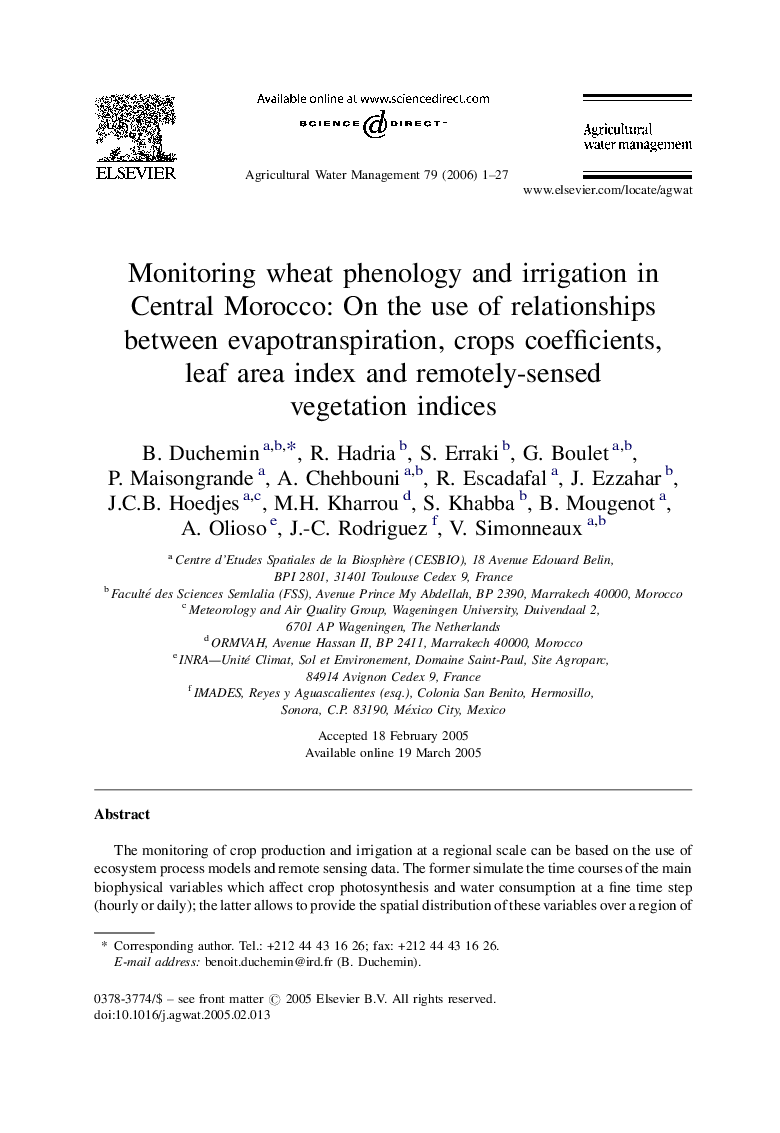| کد مقاله | کد نشریه | سال انتشار | مقاله انگلیسی | نسخه تمام متن |
|---|---|---|---|---|
| 4480655 | 1316511 | 2006 | 27 صفحه PDF | دانلود رایگان |

The monitoring of crop production and irrigation at a regional scale can be based on the use of ecosystem process models and remote sensing data. The former simulate the time courses of the main biophysical variables which affect crop photosynthesis and water consumption at a fine time step (hourly or daily); the latter allows to provide the spatial distribution of these variables over a region of interest at a time span from 10 days to a month. In this context, this study investigates the feasibility of using the normalised difference vegetation index (NDVI) derived from remote sensing data to provide indirect estimates of: (1) the leaf area index (LAI), which is a key-variable of many crop process models; and (2) crop coefficients, which represent the ratio of actual (AET) to reference (ET0) evapotranspiration.A first analysis is performed based on a dataset collected at field in an irrigated area of the Haouz plain (region of Marrakesh, Central Morocco) during the 2002–2003 agricultural season. The seasonal courses of NDVI, LAI, AET and ET0 have been compared, then crop coefficients have been calculated using a method that allows roughly to separate soil evaporation from plant transpiration. This allows to compute the crop basal coefficient (Kcb) restricted to the plant transpiration process. Finally, three relationships have been established. The relationships between LAI and NDVI as well as between LAI and Kcb were found both exponential, with associated errors of 30% and 15%, respectively. Because the NDVI saturates at high LAI values (>4), the use of remotely-sensed data results in poor accuracy of LAI estimates for well-developed canopies. However, this inaccuracy was not found critical for transpiration estimates since AET appears limited to ET0 for well-developed canopies. As a consequence, the relationship between NDVI and Kcb was found linear and of good accuracy (15%).Based on these relationships, maps of LAI and transpiration requirements have been derived from two Landsat7-ETM+ images acquired at the beginning and the middle of the agricultural season. These maps show the space and time variability in crop development and water requirements over a 3 km × 3 km irrigated area that surrounds the fields of study. They may give an indication on how the water should be distributed over the area of interest in order to improve the efficiency of irrigation. The availability, in the near future, of Earth Observation Systems designed to provide both high spatial resolution (10 m) and frequent revisit (day) would make it feasible to set up such approaches for the operational monitoring of crop phenology and irrigation at a regional scale.
Journal: Agricultural Water Management - Volume 79, Issue 1, 10 January 2006, Pages 1–27